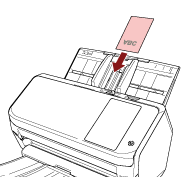Precautions
Notes on the documents to be scanned
Depending on the documents to be scanned, take note of the following.
Since carbonless paper contains chemical substances that may harm the rollers such as the brake roller and pick roller, take note of the following:
Cleaning
If paper jams occur frequently, clean the brake roller and pick roller.
For details, refer to Daily Care.
Replacing the consumables
The life of the brake roller and pick roller may end sooner compared to scanning wood-free papers.
When scanning wood containing papers, the life of the brake roller and pick roller may end sooner compared to scanning wood-free papers.
The brake roller and pick roller may be damaged when a photo/sticky note on a document comes into contact with these parts during scanning.
The surface of the document may be damaged when gloss papers such as photographs are scanned.
The light of the LED may reflect brightly when gloss papers are scanned.
When scanning semi-transparent documents, set [Brightness] higher in the scanner driver to avoid bleed-through.
When you scan documents written in lead pencil, make sure you clean the rollers frequently.
For details about cleaning, refer to Daily Care.
If documents are not fed, or documents are fed overlapped or jammed frequently, refer to Troubleshooting.
All documents must be flat on the leading edge.
Make sure that curls on the leading edge of the documents are kept within the following range.

Notes on plastic cards
When you scan plastic cards, take note of the following.
Make sure you use a card that contains the following specifications, and check if the card can be fed before scanning it.
Type: Compliant with the ISO7810 ID-1 type
Size: 85.6 × 53.98 mm
Thickness: 1.4 mm or less
PVC (polyvinyl chloride) or PVCA (polyvinyl chloride acetate)
Up to three plastic cards can be loaded in the ADF paper chute (feeder).
Note that you can only load one card at a time if the plastic card is embossed.

It is recommended that the card should be placed face-down in the ADF paper chute.
Thick or rigid cards that are difficult to bend may be fed skewed.
If there is dirt on the surface of the card, such as grease marks (fingerprints), perform scanning after wiping the dirt off.
Scanning a thick document such as a plastic card will always be falsely detected as overlapped documents.
In that case, specify one of the following settings and try scanning again.
Use the intelligent multifeed detection function.
Disable the setting to detect overlapped documents by the ultrasonic sensor.
Scan with Manual Single Mode.
